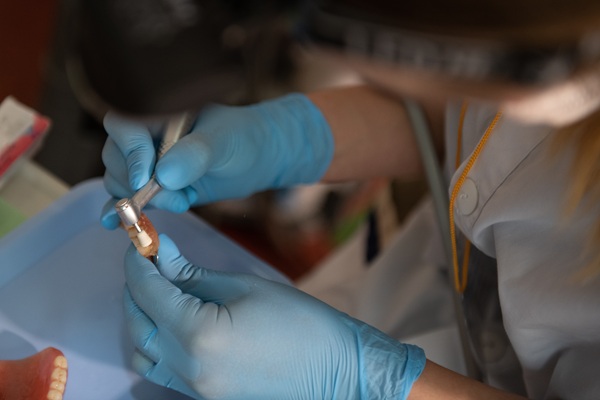When Root Canal Therapy May Be Recommended

The thought of getting a root canal is, for many people, one of the scariest dental procedures possible. This treatment can cause a person to feel nervous and anxious. The truth is that your dentist will have the knowledge and training to successfully perform this treatment without you being in much pain. It is helpful to know what to expect from the process and when it would be necessary. There are specific conditions that require this intervention.
A look at a root canal and the process
This therapy is designed to remove infection and disease from a tooth. It is an effort to save the tooth instead of extracting it. The treatment cleans out the canals on either side of the tooth’s root. To perform this procedure, the dentist will first take X-rays to assess how extensive the damage is. The dentist will then numb the patient with a local anesthetic. The dentist then places a rubber dam by the tooth to keep it clean and dry.
The dentist will then drill into the tooth through the enamel and dentin layers. Once reaching the pulp, the dentist removes it, including the nerves housed within. The dentist cleans out and sometimes reshapes the canals. If there is an infection in the tooth, the dentist may insert medication into the canals. The dentist will then seal the tooth and will often cap it with a crown.
When there is significant damage to the tooth
Breaking, chipping, or cracking a tooth can be embarrassing. This sort of cosmetic damage can affect an individual’s smile, but there are health implications too. For more widespread damage, there is a risk of infection entering the tooth and spreading throughout the mouth. The most effective way to address this is often with a root canal. Performing this treatment will prevent further damage and allow the tooth to heal.
For large cavities
For many patients, a cavity means getting a dental filling to fix the tooth. There are times, however, when a root canal will make the most sense to repair the tooth. For larger cavities, a filling will not support the tooth. Only a root canal can repair the structure and preserve the tooth. In this case, the dentist will place a crown over it after doing the treatment.
When there is an infection
There are clear signs that a person has an infected tooth, also known as an abscessed tooth. Sensitivity to hot or cold stimuli, as well as intense tooth pain, are indications that an infection has entered deep within the tooth. The patient may also have swelling in the face and jaw. There can also be tenderness and soreness. A root canal is the most effective method of removing the infection and flushing out the tooth.
Benefits of root canal therapy
Despite its unsavory reputation, root canal therapy is a procedure many people get. This is an efficient dental procedure that restores one’s damaged teeth. The tooth can remain intact, allowing the patient’s treated tooth to function well again. Below are the benefits of root canal therapy that anyone should consider:
- It boosts the appearance of teeth. This treatment removes the infected pulp. Cleaning this area and filling it with a polymer material and a dental crown can make the tooth look strong. The dentist will match the color of the crown to the color of the patient’s natural teeth.
- It prevents tooth loss. The treatment will remove the decaying or infected pulp. The dentist will also place a dental crown to keep the tooth in place. The crown can protect the tooth from future decay or damage. This can prevent severe infection and tooth loss.
- It prevents the infection of neighboring teeth. Once an infected tooth goes through root canal therapy, the dentist can stop the bacterial growth in that tooth. This can prevent the neighboring teeth from suffering the same infection.
- It is painless. The dentist will perform this procedure without pain. Numbing the area and using proper dental sedation can help the patient go through the procedure without any anxiety or fear. Patients can have oral sedation or laughing gas. People with severe anxiety can have IV sedation.
Nothing to fear: this therapy works and restores your oral health
A toothache or tooth damage can be painful and uncomfortable. It is not worth avoiding a root canal only to continue feeling these symptoms. For large cavities, tooth damage, and infections, this treatment is a good approach. Visit your dentist today if you think you may need this procedure.
Request an appointment here: https://www.roderickgarciadmd.com or call Roderick A. Garcia, DMD PC at (505) 634-5029 for an appointment in our Albuquerque office.
Check out what others are saying about our dental services on Yelp: Root Canal Treatment in Albuquerque, NM.
Recent Posts
A person may need a root canal to clean out the inside of their tooth and remove infection. However, not all infections present symptoms, and if they do, different people may experience them differently. For this reason, understanding whether you need a root canal can become tricky.While no two people are entirely alike, most will…
Hearing that you need a root canal may not be welcome news, but you can handle this procedure. Despite what you may have heard, there is minimal pain and discomfort during the process. Plus, the recovery period is usually quick. Along with cleaning out your tooth, you will likely get a crown over it. There…
Curious about the root canal process? This review discusses the specifics of what you can expect when visiting a dentist for root canal treatment. Read on to learn more about this type of restorative treatment.Every dentist has their own process for root canal treatment, but there is a general process that most follow with patients.…
A root canal is a procedure that can both relieve pain and prevent tooth loss, and nowadays, root canals are a common and painless procedure. If your tooth becomes injured or infected, bacteria can build up the inside of the tooth where the pulp and nerves reside. Left untreated, pain and sensitivity may become severe,…


